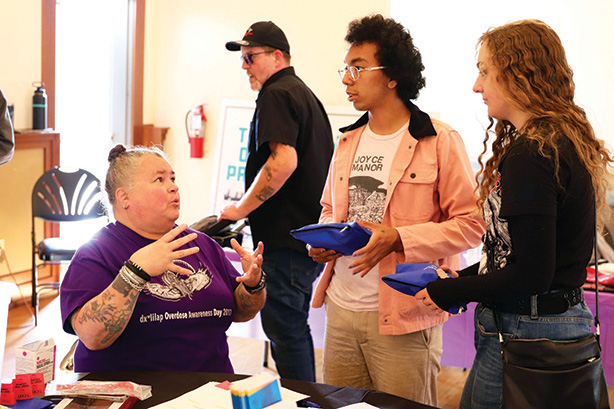
By Kalvin Valdillez, Tulalip News
Laughter has an infinite amount of healing properties. This is especially true in Native America. Nothing lifts your spirits more than a teary-eyed elder who is cracking up, or a 100+ decibel cackle by a rezzy auntie.
There was plenty of laughter to go around at the Tulalip Dining Hall on August 31, as the people enjoyed each other’s company and painted vibrant colors on small canvases throughout the afternoon. Because of the dining hall’s acoustics, the laughter bounced off the walls and amplified the good vibes on what otherwise would be a solemn gathering.
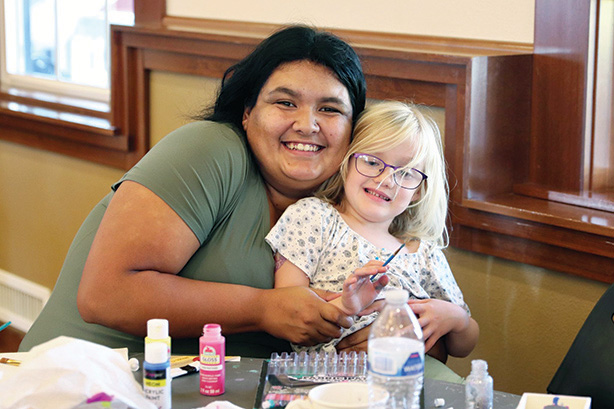
Purple streamers hung from the ceiling and tables were placed throughout the hall. There were a handful of tribal departments in attendance including the Recovery Resource Center, Behavioral Health, Quil Ceda Creek Counseling Company, Tulalip Community Health, and the Healing to Wellness Court. They setup shop with resources at the ready for those looking to attain or maintain their sobriety.
Although the tables were occupied by artists, staff and community members who grubbed down on the Panera catered dinner, one table stood alone at the far end of the room. And though we established that laughing can help those who are on a healing journey, the attendees still approached this table with a great deal of respect, as if it were a sacred space, and offered silent prayers.
After viewing the large poster at the center of the table, the event goers painted the palm side of their hands with the color of their choice and placed it on the margins of the banner, in remembrance of their loved ones who lost their battle with addiction.
“My uncle Blake passed away in June from an overdose. He was my favorite uncle,” said Tianna Moses with a heavy heart. “Today, I painted my hand and put my handprint, along with my uncle’s name, on the poster.”
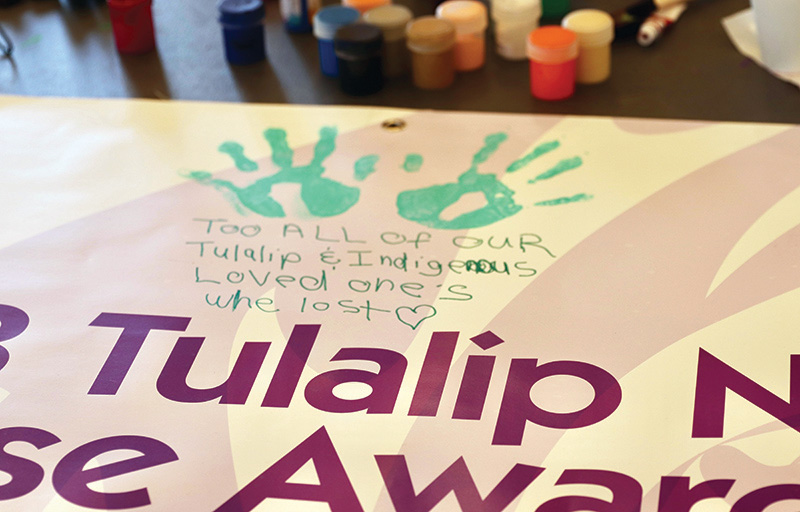
Communities across the country observed National Overdose Awareness Day as the opioid epidemic continues to spiral out of control. At Tulalip, the day is dedicated to honoring those friends and family members who are no longer with us due to overdose, as well as educating the community by providing resources, tools, and open arms.
“It is important to remember and recognize all of our loved ones who lost their lives to overdose, or in relation to substance use disorder,” said Tulalip Recovery Resource Center Program Coordinator, Kali Joseph. “It’s such a heavy topic, and it’s one of those things that we sometimes stay silent about. It involves lots of grief, and disenfranchised grief, but it is important to talk about and remember our loved ones.”
National Overdose Awareness Day also provides the chance for the local recovery community to strengthen their bonds together and continue to build a strong support system with one another. Over the past few years, the Tulalip recovery scene has grown in numbers, so much so that this year’s Recovery Campout tripled its participants from last year’s inaugural excursion to Lopez Island.
Said Tashena Hill, Recovery Resource Center Outreach Specialist, “We did the camping trip which was a huge turnout, we had over 70 clients there and they all had a whole lot of fun. Being somebody who’s in recovery, you have to find what fulfills that dopamine and gives you that umph again, so you’re able to have fun. Because if you can’t have fun in life, you’re not happy. And if you’re not happy, you’re more susceptible to going back out and using. That’s why we’re doing fun events. We’re also starting classes up at our building that are focused on things like creating job resumes.”
Kali added, “One of the biggest things that prevents relapse or recidivism is having a good social support system. When you’re surrounded by other people who understand what it’s like to be in recovery, it teaches you how to have sober fun together. And it lets you know that you’re not in this alone because there’s a lot of stigma and shame associated with addiction.”
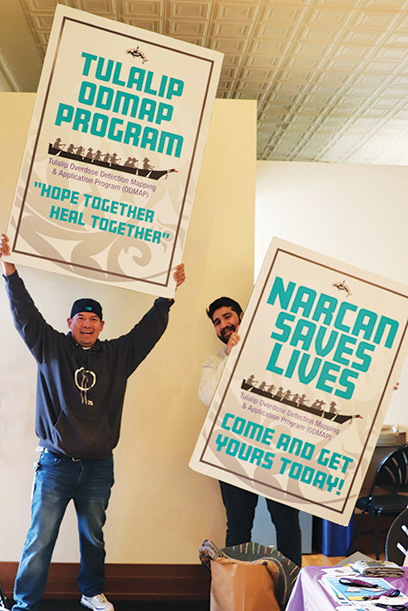
Upon entering the dining hall, each person received a Narcan kit. The overdose reversal spray is relatively easy to administer and has saved countless lives. Narcan is readily available at the Tulalip Health Clinic and the Tulalip Behavioral Health center. The Recovery Resource Center also frequently holds Narcan distributions throughout the reservation. And just recently, the program unveiled a new vending machine at the Pallet Shelter that is stocked with Narcan, as well as fentanyl test strips and hygiene products.
“I overdosed two times when I was using, so I’m thankful for Narcan,” shared Tianna. “I think everybody should have it and be prepared, because Narcan really does save lives.”
“We’ve heard from numerous clients that Narcan has saved their lives – that if they didn’t have it on hand, they wouldn’t have made it,” Tashena stated. “It’s important that people know that it’s out there now and it’s easily accessible. A life can be saved. Some people didn’t have it on them, and that’s what that handprint poster represents. It’s for the people who we lost, and if they had Narcan that day, they’d still be here with us. We hear it over and over again, ‘I wish I had Narcan that day’.”
Kali explained, “Narcan is important because it can reverse an overdose. It is like a downstream approach to prevention but it’s important because it will save the person’s life right then and there. It opens up more windows of opportunity for that person to get sober and live a better life. And it gives them more hope and time to decide that they are ready to change their lives.”
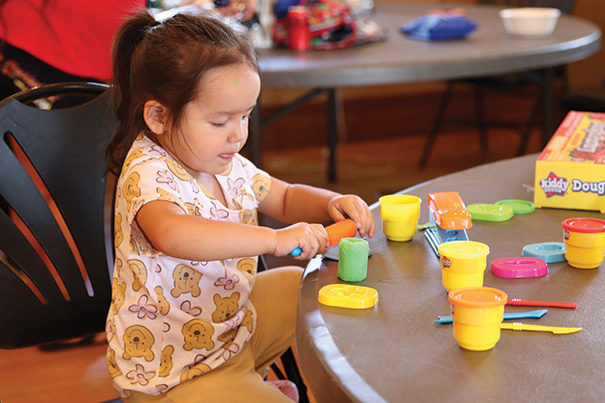
According to the Snohomish County Opioid Overdose and Prevention Data and Dashboard, there were 215 overdose deaths in the county last year, an increase of 115 people when compared to 2017’s statistic of 100 deaths by overdose. And the most recent data shows that this year, at least 66 people have died due to an opioid overdose in the first quarter of 2023.
There have been numerous studies throughout the years, from the likes of the CDC and Washington Post, that show Native communities have been hit the hardest by the opioid crisis. The Albuquerque Area Southwest Tribal Epidemiology Center’s (AASTEC) research indicates that in 2021, the opioid overdose death rate for Natives was 38.7 deaths per 100,000 nationwide.
With this current trend, the epidemic shows no signs of slowing down. Even so, Tulalip is taking proactive measures by offering multiple programs and resources that are dedicated to helping their membership gain their sobriety and live a clean and healthy lifestyle.
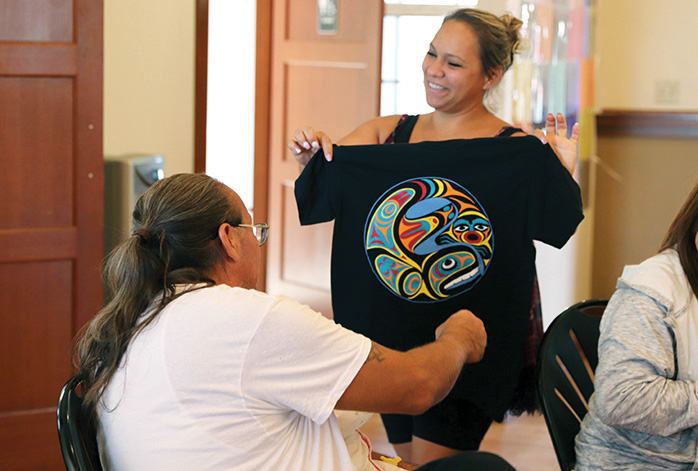
The event concluded with a raffle, in which people won items such as Coast Salish laced t-shirts, mugs, and blankets. The National Overdose Awareness Day event was a lighthearted gathering where the community reminisced about their late loved ones and honored all those lives lost due to an overdose.
Tianna expressed, “I wish there were events like this happening when I was using, so I could’ve seen that there are people who care and are really out there to help. I was in active addiction for almost eight years, I’m 25 so that’s a long time. I never thought I would be sober again. I thought death was going to be my only way out. And that’s why this event is important, because it spreads awareness, and it shows people that we can recover.”
For additional information, please contact the Tulalip Recovery Resource Center at (360) 716-4773.